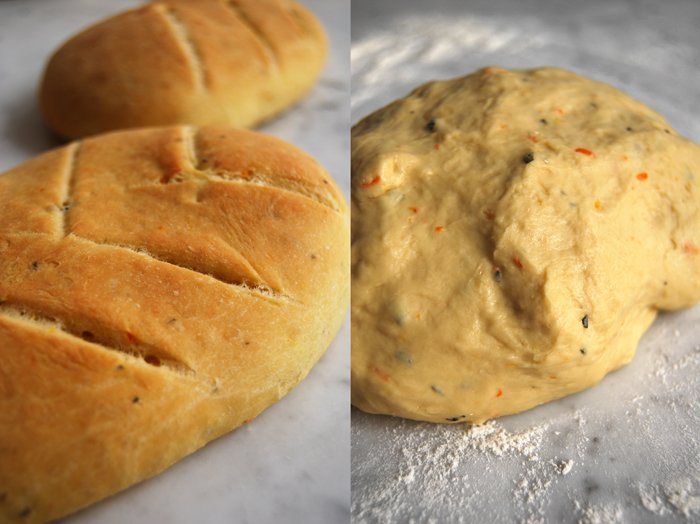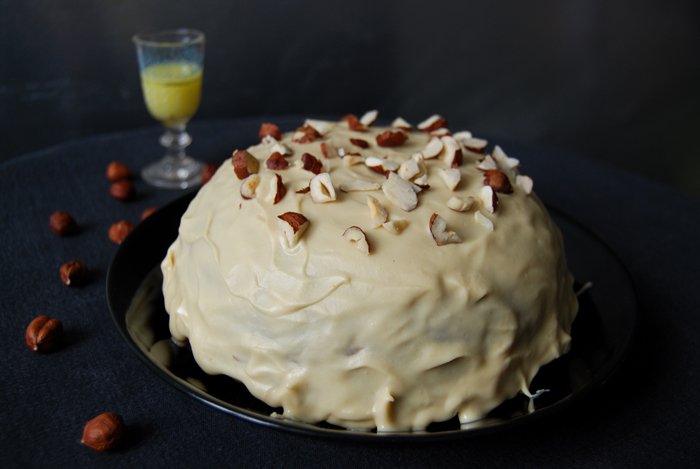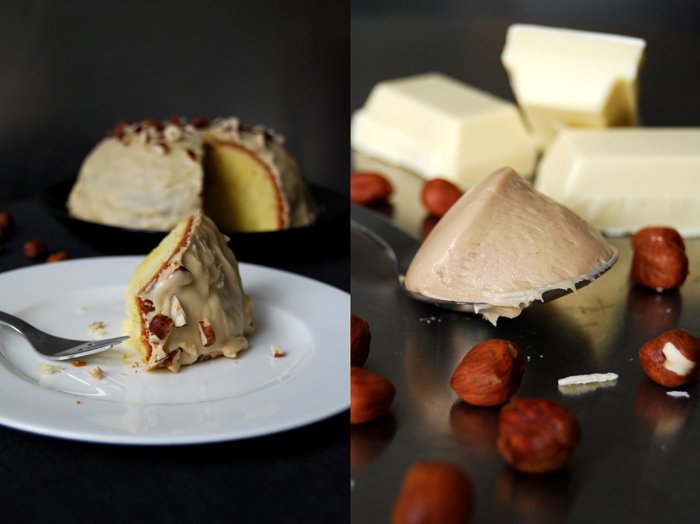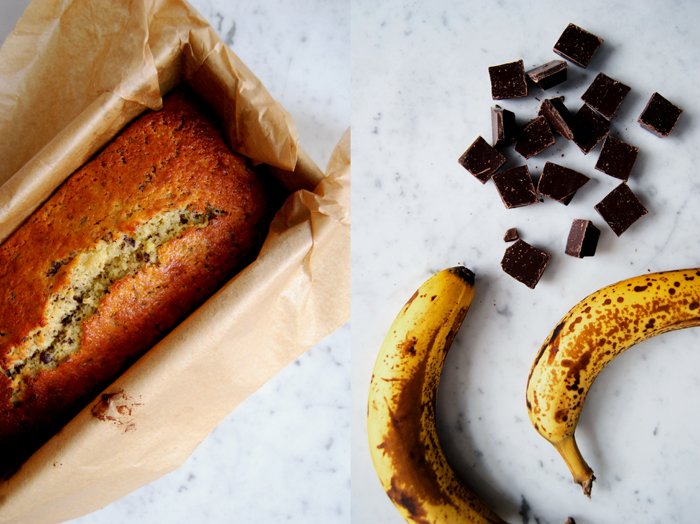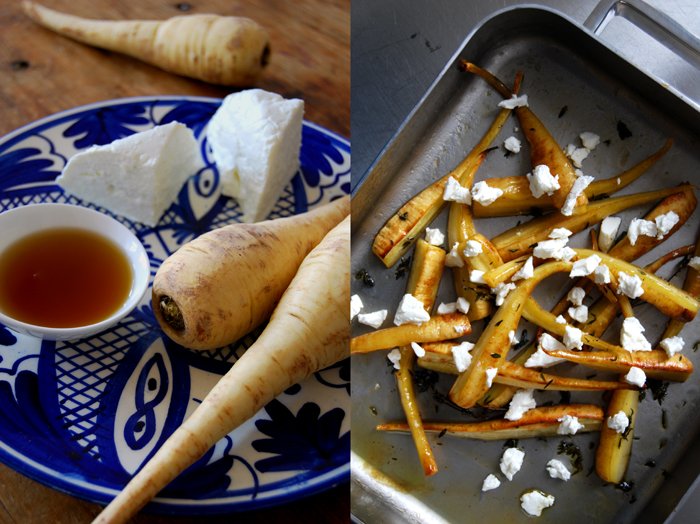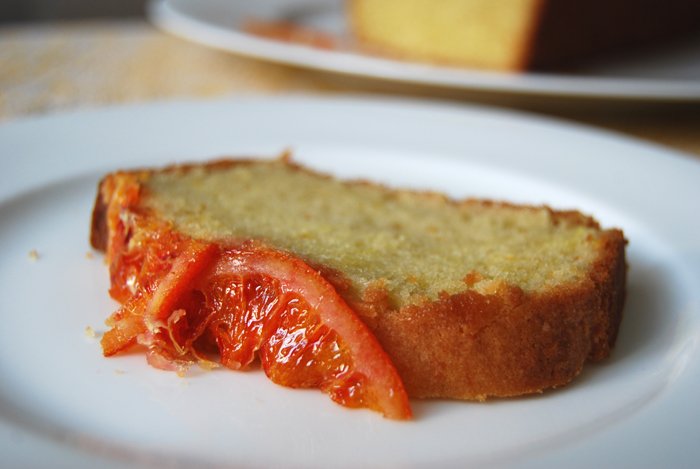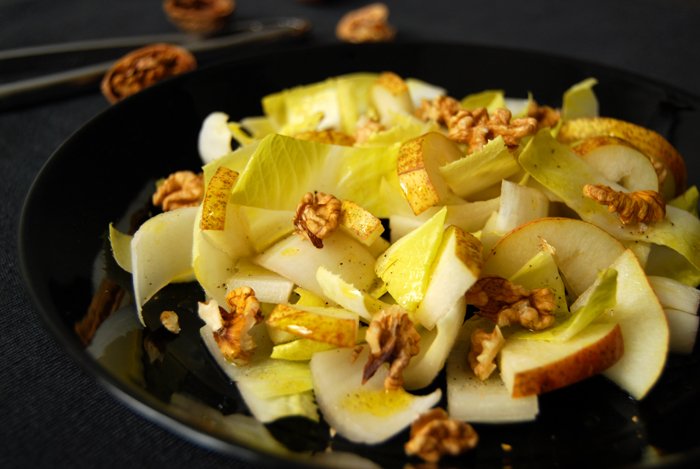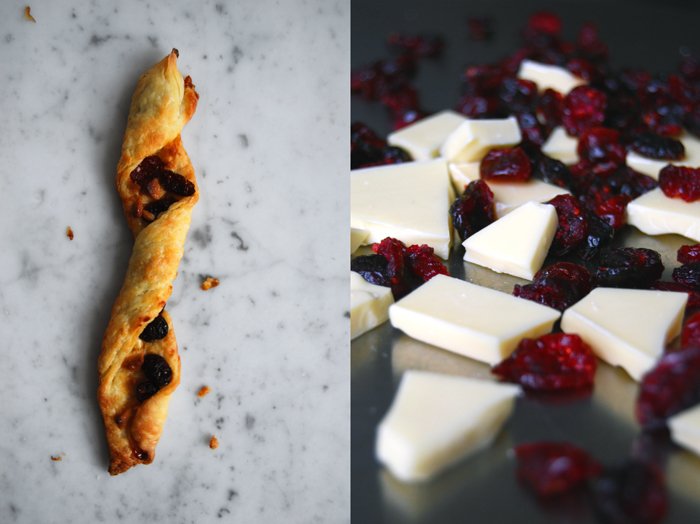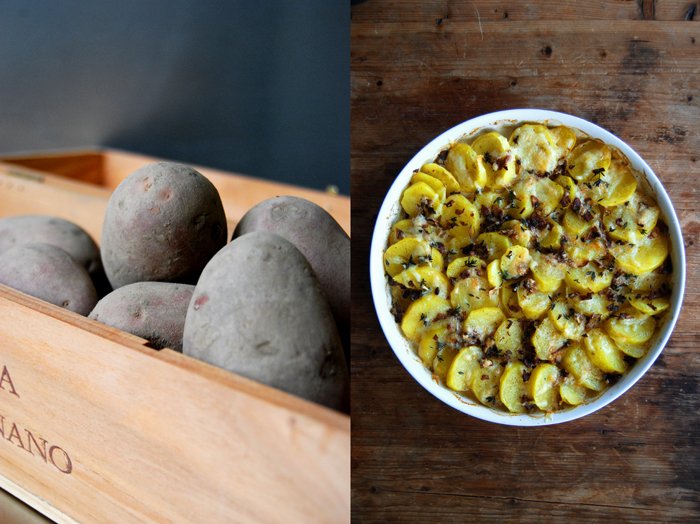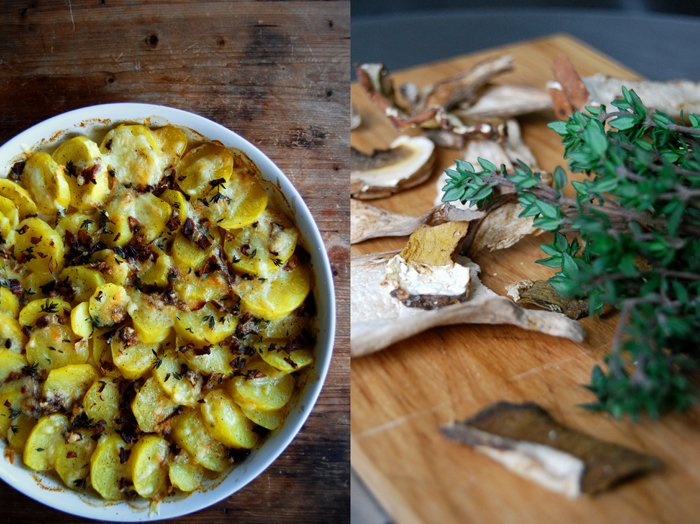Fougasse Bread with Orange, Sage and Olive Oil
It's time to bake bread again! I use a recipe which involves sage and my beloved blood oranges, they'll be out of season soon, so I'm using every possible occasion that allows me to cook or bake with my sweet citrus fruits. I mix generous amounts of their zest and juice into the dough and the result is impressive!
My bread is a light and aromatic Fougasse, a French flatbread very popular in Provence where it's often made with olives, herbs and cheese. It's similar to the Italian Focaccia but with a leaf pattern of cuts in the dough. In some recipes, the cut goes all the way through creating holes in the bread while it's baking which makes the bread harder. I prefer to leave mine juicy with shallow cuts on the surface. Besides the orange and sage I add good olive oil in and on the bread. I use the wonderful extra virgin olive oil from the Molise region which I got from Marilena. Its strong and fruity taste is just what my Mediterranean flatbread needs!
I already have a great idea for a sandwich I can make with this bread for tomorrow's Sandwich Wednesday!
Fougasse with Orange, Sage and Olive Oil
For 6 flatbreads you need
plain flour 400g / 14 ounces (I use spelt flour type 630 but you can use any other plain flour)
dry yeast 1 package (for 500g / 1 pound flour)
salt 1 teaspoon
fresh sage, chopped, 8-10 leaves
zest of 1 medium sized orange
freshly squeezed blood orange or orange juice 100ml
water, lukewarm, 100ml
olive oil 5 tablespoons plus more for brushing the bread
organic egg 1
Combine the flour, yeast, salt, orange zest and sage in a large bowl. Add the water, orange juice and egg and mix with your dough hooks for 5 minutes. On a floured surface, continue kneading with your hands for a few minutes until you have an elastic dough ball. Put the dough back into the bowl and cover with a tea towel. Let the dough rise in a 35°C / 95°F warm oven for 45 minutes. This works really well but make sure that your oven is set to top/ bottom heat and not to fan.
Take the dough out and punch it down. Divide it into 6 pieces and roll them out into egg shaped discs (on a floured working surface, around 1 1/2 cm / 1/2″ thick). Put them on a baking sheet lined with parchment paper, cover with a tea towel and let them rise for 20 minutes.
Set your oven to 210°C / 410°F.
Brush the flatbread with olive oil and cut a pattern of 6-8 diagonal slashes into the dough to make a leaf pattern. Bake the flatbread on the lowest level for 12-15 minutes or until golden brown. Take them out and let them cool for 2 minutes.
I cut the warm flatbread in half and drizzled some more olive oil over it, it merged perfectly with the orange and sage aromas!
Marilena's Milk Pan di Campobasso, a traditional Dolci del Molise
I have wonderful news, eat in my kitchen is in the final of the Kitchn's "Best Daily Read Cooking Blog" together with nine other blogs! Thank you for your support and help to come so far!
It would be great if you could vote (one last time, I promise) for the final vote of the "Best Daily Read Cooking Blog" here.
A few weeks ago a very sweet lady, Marilena, got in touch with me. It was the day I wrote about Mussel with Ginger, Lemon Grass and Coriander and we got to talking about seafood recipes, cakes and olive oil. At one point she asked me if I would like to try one of her cake recipes, the Milk Pan di Campobasso.
Marilena lives in Italy in the Molise region (in the Campobasso province) which is north-east of Napoli. She loves to bake, beautifully decorated cakes for weddings and special events and she produces her own olive oil, Marilena has 300 olive trees! She already sent me some of her wonderful extra virgin olive oil which is divine, a few drops on fresh bread and some salt, delicious!
So finally I baked her cake, Marilena's Milk Pan di Campobasso. I was excited, it's a special recipe, a traditional Dolci del Molise and it required a few preparations. First I had to get a special liqueur, the Italian Strega (meaning "witch") which is a herbal liqueur produced since 1860, bright yellow made with saffron, mint and fennel. I ordered it and when it arrived I prepared the "liqueur milk". A mixture made of milk, Strega liqueur, sugar, saffron, vanilla and lemon peel which has to sit overnight, it gives the Milk Pan its typical taste and yellow colour. The cake is baked in a dome cake tin, it's very juicy, a bit moist but still light. It is covered with a glaze of nocciola cream, a hazelnut spread, mixed with white chocolate and sprinkled with hazelnuts. It's hard to describe the taste, it's the taste of Italy, wonderfully sweet and aromatic, with a slight hint of saffron which is a great match to the hazelnuts. I love it, thank you Marilena!
Milk Pan di Campobasso
For this cake you need a 1 liter dome cake tin (mine is ceramic, you can also use a metal one).
For the liqueur milk
I made more liqueur milk than I needed for the cake as I want to use it for other dessert recipes as well. You will need around 50ml (one espresso cup) of this mixture for the cake.
milk 50ml
granulated sugar 50g / 2 ounces
Strega liqueur 50ml (you can also use another herbal liqueur with fennel and saffron)
a tiny pinch of saffron
the seeds of 1cm / 1/2" vanilla bean
a long strip of lemon peel
Mix all the ingredients in a bowl, cover and let them infuse overnight.
For the hazelnut chocolate icing and topping
white chocolate 150g / 5 ounces
nocciola cream (hazelnut spread) 2 big tablespoons
sunflower oil 2 tablespoons plus more for mixing
hazelnuts, chopped, 3 tablespoons, or more if you like for the topping
In a sauce pan, melt the chocolate on low temperature and stir in the hazelnut spread and oil. It should be smooth and liquid, if it's not liquid enough you will have to add a little more oil.
For the cake
butter, soft, 150g / 5.5 ounces
granulated sugar 150g / 5.5 ounces
organic eggs 3
pinch of salt
plain flour 80g / 3 ounces
potato starch 80g / 3 ounces
baking powder 1/2 teaspoon
liqueur milk, 1 espresso cup (around 50ml)
Set the oven to 180°C / 355°F ( (fan-assisted oven), butter the dome cake tin and sprinkle with breadcrumbs.
Beat the egg whites with a pinch of salt till stiff. Combine the flour, potato starch and baking powder. In a large bowl, beat the butter and sugar till fluffy, add the egg yolks, one at a time. Stir in the dry ingredients and the liqueur milk and continue mixing until well combined. Gently fold in the egg whites.
Scrape the dough carefully into the prepared tin and bake until golden. Check with a skewer, it should come out clean. Marilena told me to check it after 30 minutes, mine needed 55 minutes. The baking time depends on the shape, size and material of your tin.
Let the cake cool (I put the tin in cold water which makes it easier to take the cake out), carefully flip it over on a big plate and ice it with the hazelnut chocolate icing. Sprinkle with hazelnuts and enjoy its beauty (and taste)!
Sweet and Spongy Banana Chocolate Bread
This is another perfect weekend breakfast treat, Banana Chocolate Bread. I like mine juicy, almost moist, with lots of big pieces of banana and bittersweet chocolate chunks. When you take the bread out of the oven, golden and warm and you cut the first thick slice off the loaf, pushing the knife through sweet banana chunks and melted chocolate, you'll understand why there's no better start to the weekend. It feels, smells and tastes just right! I never wait for the bread and chocolate to cool, I have to eat a slice immediately as soon as it's done, the chocolate still warm and liquid.
The combination of banana and bittersweet chocolate is a special one as the sweetness and the bitterness balance each other out perfectly. I love it in ice cream, cookies and cakes, but to me nothing beats this duo when their big chunks merge into a warm cake, or morning bread. For one loaf I use three big bananas and 100g / 3.5 ounces of bittersweet chocolate, I don't want a hint of their flavours, I want an explosion on the taste buds.
Banana Chocolate Bread
For a 24cm x 10,5cm / 9.5″ x 4″ loaf tin you need
butter 120g / 4.5 ounces
granulated sugar 100g / 3.5 ounces
vanilla sugar 1 package (you can also use vanilla extract)
organic eggs 2
large and ripe bananas, quartered, 3
plain flour 120g / 4.5 ounces
baking powder 2 teaspoons
salt 1/2 teaspoon
bittersweet chocolate, chopped roughly (leave a few bigger chunks), 100g / 3.5 ounces
Set the oven to 160°C / 320°F (fan-assisted oven) and line the loaf tin with parchment paper.
Combine the flour, baking powder and salt. Mix the butter together with the sugar and vanilla sugar till fluffy. Add the eggs, one at a time, and continue beating for a couple minutes. Add the bananas, beating for 10-20 seconds and stop before they get too smooth, they should be a bit chunky. Gently fold in the flour mixture with a spoon, add the chocolate chunks and fold them in, carefully as well. Scoop the dough into your prepared tin and bake for 55 minutes or until golden brown. Check with a skewer, it should come out clean.
A Salad of Caramelised Parsnip with Maple Syrup, Goat Cheese and Thyme
At the moment I could eat roots and turnips all the time luckily, as tasty spring vegetables are still a few months away. It's always the same, around March I start to miss ripe tomatoes, juicy cucumber, crunchy lettuce, zucchini, the ripe tastes of summer. Greenhouse vegetables reach their watery peak at this time of the year so they are not really an alternative. The cherry tomatoes I bought the other day had thick skin and when I ate them I had to image tomatoes rather than tasting them. I don't really feel like cabbage anymore, so I stick to everything that grows in the ground.
I enjoyed my Monday's Ginger Honey Navet Steaks so much, their sweet, syrupy juices were delicious, that I thought about other combinations of roots and syrup. My choice was caramelized parsnip roasted with maple syrup and thyme leaves, combined with fresh goat cheese in a warm salad. The juices make a great thick syrup, glazed around the roots they are a perfect match for the milky cheese crumbs and strong wintery herb. You could make it as a side dish, still hot, we ate it as a warm salad, I didn't want the cheese to melt.
I cut three parsnips into long strips and glazed them with 3 tablespoons of olive oil and 2 tablespoons of maple syrup mixed with salt and pepper. A dash of white wine and the leaves of 4 sprigs of time on top, everything well spread in a roasting tin, I baked it for 15 minutes in the hot oven set to 200°C / 390°F, Rotitherm roasting setting. When the parsnip was done, golden on the outside and soft inside, I let them cool for a couple minutes before I crumbled 80g / 3 ounces of fresh, soft goat cheese over the roots. The two us cleaned the tin with our fingers, not to waste a drop of the sweet syrup.
Roast Quail with Spice Crust
I remember when I was a child I refused to eat quail, I didn't like the idea of cooking a bird of that size. I got older, learnt that there is no difference between eating chicken, quail or any other fully grown bird and then one day, I tried a piece of its juicy meat. I was convinced within seconds! I have since tried out many recipes, fruity with roast grapes, quail with different herb variations, pure and buttery, exotic quail with various spice mixtures, so many possibilities that change with the seasons. There's one thing these recipes have in common, I always fry the quail in fat with a piece of garlic and then I roast it in the oven for 8-10 minutes. It makes the skin crisp and the meat doesn't loose its juices.
You can play around with quite a few aromas because it tastes so strong, it allows you to be more experimental than with chicken. I love to look through my big box of spices and follow my nose to choose the right mixture. It makes me feel like a child in a sweet shop! This time I go for 1 small star-anis, 2 cloves, 12 black pepper corns, 1 teaspoon of coriander seeds and 1/4 teaspoon of aniseed, everything ground coarsely in my mortar. This spice mixture makes the crust for 2 quails. I had some goose fat in the fridge, perfect for frying poultry but you can use butter instead. I fried the birds together with 1 clove of garlic cut in half until their skin was golden brown on all sides and put them into a baking dish. The buttery juices mixed with a dash of lemon juice go over the quails, followed by the spices rubbed into their skin and some salt. Now they just need to go into the oven, set to 200°C / 390°F, I used the Rotitherm roasting setting which works perfectly for poultry. Mine were done in 8 minutes, I had bigger quails which needed up to 15 minutes depending on their size.
We focused on the quail and enjoyed this meal with slices of white bread to dip into the spiced juices and a salad on the side.
Bacon Sandwich with Balsamico Basil Cream Cheese
Before I tell you about my idea for this week's Sandwich Wednesday I would like to share some great news! Eat in my kitchen has been nominated for TheKitchn's "Best Daily Read Cooking Blog" which makes me very happy and proud. It would be great if you could take a minute to vote for eat in my kitchen (voting ends this Saturday the 22nd February) at this link: http://thekitc.hn/1gBlL11
Thank you for your support, Meike xx
Back to my sandwich, this week I was in the mood for hearty, dark bread, topped with Balsamico cream cheese and crisp bacon. One of my favourites from my local bakery is an organic spelt potato bread, juicy but with a nice crust. It's similar to rye bread, just a bit lighter with the advantage that the loaf stays fresh longer because of the starch from the potatoes. Cut into thick slices, it's perfect for a late winter sandwich. I also bought some very strong bacon, a bit on the salty side. To balance this out I combine it with a smooth, milky cream cheese enhanced with Balsamico and basil. This is a great spread, I also use it on slices of grilled aubergine rolled up into little antipasti. Delicious, but I'll write about that another time!
For this week's sandwiches - for 2 as always - you need 4 slices of dark bread (spelt or rye), one side spread with my Balsamico basil cream cheese mixture. For the spread you mix 70g / 2.5 ounces of cream cheese with 2 tablespoons of heavy cream, 1 1/2 teaspoons of Balsamico, 8 basil leaves sliced thinly and salt and pepper to taste. When this is done you just need to fry 6 slices of bacon until golden brown and crisp and lay them on the cream cheese. Sprinkle with some more Basil, close with another slice of bread if you like and enjoy!
Ginger Honey glazed Navet Steaks with Orange Juice and Rosemary
When I saw these beautiful yellow turnips, also known as Navet, at the store, I had to buy them although I wasn't really sure what to cook with them. They are related to beetroot but taste more like rutabaga. After 1 or 2 days of looking at them I found my inspiration, thick Navet steaks fried in butter with ginger, honey, orange juice and rosemary. I made a similar recipe with rutabaga in December and the combination of turnip and ginger is one that I like a lot.
This time, I wanted to add a few more aromas, the sweetness of honey, the fruity sourness of orange juice and some woody rosemary, all this combined in the buttery juices of my yellow turnip. The result left me speechless! I couldn't get enough of this sauce, so thick, sweet, spicy and sour, simply amazing, and the Navet steaks covered in this sticky glaze combined perfectly with all the different flavours.
Ginger Honey glazed Navet Roots with Orange Juice and Rosemary
For a lunch or side dish for 2 you need
yellow turnip, cut into thick steaks, 2 (you can also use rutabaga)
ginger, grated, a thumbnail sized piece
honey, 1 teaspoon
orange juice for deglazing
fresh rosemary, chopped, 2 tablespoons
butter 3 tablespoons
salt and black pepper
In a large pan, heat the butter together with the honey and ginger, add the turnip and season with salt and pepper. On medium heat, fry for 2-3 minutes on each side until golden brown. Deglaze with a splash of orange juice, let it cook for 1-2 minutes and sprinkle with rosemary.
Elsa's Poppy Seed Crumble Cake
My aunt asked me for a helping hand in the kitchen because she had a baking marathon of three cakes to manage in one day, so I decided to bake one of them. She let me choose, they all sounded nice but I went for a recipe which I wouldn't usually bake. It's a poppy seed crumble cake with a sweet yeast dough, an old German recipe which she got from her friend Elsa many years ago.
I'm happy about my choice as the yeast dough alone is already wonderful, light and not too sweet. I will definitely use it for other recipes soon, maybe a Sunday morning Challah (plaited yeast cake). Although it's so light and spongy it's still strong enough to carry the thick layer of smooth poppy seed cream, semolina, ground almonds and raisins. If this wasn't enough, the cake is topped with crunchy buttery crumbles (I used the crumble recipe of my Apple Crumble Cake).
When I was a child, I loved poppy seed swirl cake. I couldn't get enough of it, but then at one point I lost interest for no apparent reason. So for years I haven't baked with these crunchy black seeds at all but I think they will return to my kitchen after this cake!
Poppy Seed Crumble Cake
For a 39 x 32cm / 15.5 x 12,5" tray of cake you need
For the yeast dough
plain flour 500g / 1 pound
dry yeast 1 package (for 500g / 1 pound of flour)
granulated sugar 60 g / 2 ounces
a pinch of salt
milk, lukewarm, 150ml
butter, melted and cooled, 100g / 3.5 ounces
organic eggs 2
Combine the dry ingredients, add the milk, butter and eggs and mix with your dough hooks for 5 minutes. Continue kneading with your hands for a couple minutes. Put the dough back into the bowl, cover with a tea towel and let it rise in a 35°C / 95°F warm oven (top / bottom heat) for about 45 minutes until well risen.
Prepare a baking sheet with parchment paper. Roll out the yeast dough and put it on the baking sheet. Cover with a tea towel and let it rise for 15 - 20 minutes in a warm place.
Set the oven to 175°C (top / bottom heat) and prepare the poppy seed mixture and crumbles.
For the poppy seed mixture
semolina 125g / 4.5 ounces
granulated sugar 150g / 5.5 ounces
salt 1/4 teaspoon
milk 1000ml
organic egg yolks 2
poppy seeds, crushed, 250g / 9 ounces
almonds, ground, 100g / 3.5 ounces
raisins 50g / 2 ounces
zest of 1 lemon
In a large pot, bring the milk, semolina, sugar, salt and egg yolks to the boil, stirring constantly. Continue stirring and let it cook for 5 minutes on medium heat. Add the poppy seeds, almonds, raisins and lemon zest, combine everything and set aside.
For the crumbles
The crumbles need good preparation as you have to make sure that the mixture is neither too moist nor too dry. Have some extra flour and melted butter close at hand so that you can add some immediately if necessary.
plain flour 200g / 7 ounces (plus more if the crumbles are too sticky)
granulated sugar 125g / 4.5 ounces
vanilla sugar 1 teaspoon
butter, melted, 125g / 4.5 ounces (plus more if the crumbles are too fine)
Combine the dry ingredients in a bowl. Pour the melted butter on top and mix quickly with the hooks of your mixer, this shouldn’t take longer than 20 seconds. If the crumbles are too moist and sticky add a bit more flour (1-2 tablespoons). If they are too fine and don’t form bigger crumbles add more melted butter.
For the cake, spread the poppy seed mixture over the yeast dough and sprinkle with the crumbles. Bake the cake for 40 minutes or until the crumbles are golden.
French Toast with Maple Syrup for a cosy breakfast in bed
French toast is the perfect breakfast for a cosy day in bed, with books and magazines, daydreaming and chatting, with nothing important on my mind and no decisions to be made. While pancakes are an equally satisfying morning treat, they take a bit more time so I gladly make my french toast on a day like this. It requires just a few minutes out of bed for preparation before I can snuggle back into the cushions with a plate full of sweet cinnamon toast covered in maple syrup.
I like my french toast soft and juicy on the inside, soaked in lots of cinnamony milk with eggs, and with a buttery crust on the outside. For 4 slices of white bread I mix 2 large eggs with 1/3 to 1/2 cup of milk (depending on the size of the eggs), the mixture should be quite liquid. I whisk in a pinch of salt and 1/8 teaspoon of ground cinnamon, then I let the bread soak in this mixture, turning it once or twice, repeating with the other slices until most of the liquid is absorbed. Now they just need to fry in 3 tablespoons of butter in a large pan on medium heat until golden brown before you can sprinkle them with more cinnamon and pour over some maple syrup.
The taste of Summer in my Mediterranean Sandwich
Maltese sausage, tomatoes, capers, olives, basil, red onions, garlic and olive oil on Maltese Ftira bread - as soon as I started to make this sandwich the sun came out, literally! You can't really put more of the taste of summer into a sandwich than in this one. In Malta, this is a local hero, the famous Ftira, enjoyed by everyone on this island. It's a celebration of their specialities combining quite a few different tastes, all strong and honest, and creating one of the best sandwiches you can imagine.
I made it last weekend when I had all the ingredients at hand, freshly delivered from Malta by Emma. I fried the coarse Maltese sausage with its strong coriander flavour until golden brown, without its skin and cut in half. It looked a bit like a burger stuffed with herbs. You can also use Salsiccia as it's made with similar spices and herbs as well. I recommend a white bread with a nice crust but soft on the inside to soak the juices and olive oil like the Maltese bread I used. I cut a few cherry tomatoes, half a red onion, 4 green olives, 1 dried tomato and a few basil leaves into slices and piled everything carefully onto a slice of bread drizzled with olive oil. I finished it off with 1 crushed clove of garlic and a few capers and closed it with another slice of bread. When I took a bite, I was on my favourite island in the Mediterranean again!
Beetroot and Apple Carpaccio with Pomegranate
A quick carpaccio in bright red with cooked beetroot, apple and pomegranate to welcome a special guest! My mother will be at my home (and in my kitchen) over the next few days. I'm sure we'll be out a lot but I really hope we'll find some time to cook together which I enjoy a lot!
I'm a big fan of vegetable carpaccio. It allows you to combine different flavours in a very pure, quick to make and beautiful way. All you have to do is slice a vegetable or fruit very thinly, arrange it and top with a simple dressing. My red carpaccio is based on the strong, earthy-sweet taste of cooked beetroot which combines perfectly with the sweetness of the apple and pomegranate. I cooked the roots in a bigger batch - as I do every week - in salty water with two bay leaves for 50 minutes (depending on their size they might need shorter but mine were big). For my carpaccio for 2 I need 1 root cut thinly with a slicer, 1 sweet apple prepared in the same way and the seeds of 1/3 of a pomegranate. I drizzle my current favourite lunchtime dressing on top, 3 tablespoons of olive oil mixed with 2 tablespoons of white Balasamico and season it with salt and pepper. It's a great lunch, as pretty as it is tasty!
Blood Orange Cake
Two things led to this cake, firstly, I haven't written about blood oranges in more than two weeks, secondly, my mother. She reads (nearly) everything I share on eat in my kitchen, she is my mother after all. She recently mentioned that my photos could do with some new decoration. She's a woman of action, so within a few days she sent me a parcel packed with some pots, silver plates and a selection of her favourite linen from an artisan weaver in the Italian Dolomite Alps. I'm not really a big decorator, I'm more of a minimalist but I'm open to some inspiration, especially when it comes from my mother.
The package arrived, with beautiful handwoven craftsman's work, a table cloth and runners in various colours and designs. One of them caught my attention, a golden yellow design, a bit more frilly than my usual style but I liked it. I knew it would need to be paired with the right food to unfold its beauty. The inspiration came within a split second, a spongy blood orange cake with sugared slices on top, a bit opulent and the fruits are also from Italy, like the cloth.
Blood Orange Cake
For this recipe you need a 24cm x 10,5cm / 9.5" x 4" loaf tin.
butter, soft, 180g / 6.5 ounces
granulated sugar 180g / 6.5 ounces
organic eggs 3
blood orange zest 2 tablespoons
freshly squeezed blood orange juice 3 tablespoons
plain flour 210g / 7.5 ounces
baking powder 1 teaspoon
For the topping
blood orange, cut into very thin slices, 1
granulated sugar 50g / 2 ounces
water 2 tablespoons
icing sugar 2 tablespoons, for the syrup
freshly squeezed blood orange juice 4 tablespoons, for the syrup
Set the oven to 160°C / 320°F (fan-assisted oven) and line your loaf tin with parchment paper.
For the topping, cook the orange slices, sugar and water in a sauce pan on high temperature for around 5 minutes until the water has evaporated. Put aside.
Mix the butter together with the sugar till fluffy. Add the eggs, one at a time, and continue mixing for a couple minutes. Mix the orange juice and zest into the mixture, gently fold in the flour combined with baking powder and scoop into your prepared tin.
Bake for 35 minutes, take it out and arrange the sugared orange slices on top. Bake for another 15 minutes. Check with a skewer, it should come out clean.
Mix the icing sugar with 4 tablespoons of blood orange juice for the syrup and pour over the cake (you can spike the top of the cake first).
Sandwich Wednesday with Camembert and Juicy Pomegranate
It felt like a lot of people enjoyed my Stilton and Pear Sandwich a couple weeks ago as much as I did. I received quite a few messages from people who tried it and loved it which made me think about further possible cheese and fruit combinations. There are a million variations but I particularly love a mix of sweet and aromatic flavours. When it comes to cheese, I'm the kind of person who eats what others might consider to be beyond the expiry date, to me a cheese can't be too ripe. There is a wonderful cheese section in my favourite department store which has - as you can imagine - a very distinct smell in the air. So when I go there with friends you can be sure that when the others are already on the run, I'm still standing there fascinated by the variety. When it comes to cheese, I feel no pain!
At the moment I buy a lot of pomegranate, they are sweet and juicy (and full of antioxidants which isn't bad either). So the fruit is set. My cheese of choice is an an aged Camembert, so stinky that I have to wrap it twice and put into a box to keep the rest of my fridge safe, but it tastes delicious! I bought a loaf of Ciabatta, my current favourite for sandwiches when I don't bake my own bread, which I cut in half and cover with thick slices of my creamy Camembert (for 2 people I needed around 90g of this cheese). I baked it in the oven under the grill for just 20 seconds, any longer and there wouldn't be any cheese left. This one melts really quick! I kept a baking dish under it to collect the cheese running down the sides of the bread. When it was golden brown, I took it out and sprinkled my sandwiches with the seeds of 1/3 of a pomegranate and crushed black pepper.
Sweet Pear and Bitter Chicory Salad
This was my favourite salad during my university years! When I was too busy to cook or my fridge didn't have much to offer, this was always an option (besides spaghetti with tomato sauce). A crunchy sweet and bitter combination which I always love but here especially together with the walnuts. In winter I make sure I have these three in stock, pear and walnuts as a quick snack and chicory is one of my quick emergency dinners. If I'm running out of time, I cut 2 chicories in half, fry them in butter, golden brown on each side and season them with salt and pepper - done.
For my salad I need 2 chicories and 1 pear, both sliced in strips, enough to feed 2-4 people. At lunch time people have different eating habits so it's hard to estimate the exact amounts. At a dinner party this is definitely enough for a a side dish for 4. I make a light dressing with 3 tablespoons of olive oil mixed with 2 tablespoons of white Balsamico (I can't live without this vinegar in winter!), seasoned with salt and pepper. You could also add some fresh lemon juice. Some walnuts on top and I'm back in my student years!
Flaky White Chocolate and Cranberry Twists
I've been wanting to bake something with white chocolate and cranberries since December but this idea never reached my oven - too much to bake, too little time. I was drawn to this combination last winter when I mixed them into my crunchy cookie recipe. The chocolate and the berries gave them a nice sweetness, milky and fruity. I enjoyed them so much that I decided to share them with our family and friends in Malta, so I sent them a big parcel stuffed with these cookies at Christmas time. The box was emptied within moments as we witnessed on Skype.
This weekend I felt like this duo again but didn't want to bake cookies. Croissants are more what I had in mind, just without the hassle of making two different doughs for the perfect puff pastry. I thought of my buttery flaky Rugelach, this dough is made to be wrapped around a sweet filling but I wanted something bigger, not just a mouthful - a handful! This is a Sunday morning pastry which you hold in your buttery fingers while you sip your coffee. I went for a long and twisted shape, quick to prepare, easy to eat, no hassle on a Sunday - Good morning everybody!
White Chocolate and Cranberry Twists
For 16 twists you need
plain flour 150g / 5 ounces
icing sugar, 1 heaped tablespoon
butter, cold, 125g / 4.5 ounces
cream cheese, at room temperature, 120g / 4.5 ounces
a pinch of salt
white chocolate, chopped, 70g / 2.5 ounces for the filling
dried cranberries 70g / 2.5 ounces for the filling
For the filling, mix the chocolate and cranberries.
Combine the dry ingredients. Cut the butter with a knife into the flour mixture until there are just little pieces of butter left. Mix with your dough hooks for a few seconds. Add the cream cheese and work it into the mixture with a spoon or the mixer until you have a crumbly mixture. Form 2 discs and put them in the freezer for 30 minutes. The dough should be very cold but not too hard, still rollable.
Preheat the oven to 185°C / 365°F and prepare a baking sheet with parchment paper.
Take out one disc, leave the second one in the fridge while you're preparing the first batch. Roll out the disc between floured cling film as the dough becomes very sticky at room temperature. Give it a rectangular shape, the width will be the length of your twists. Cut off a 4.5cm / 2" strip and pull it off the foil (don't worry if it's sticky, it's an elastic dough, you can also use a knife to lift it). Lay the pastry strip flat on your working surface, sprinkle with the filling, pushing it a little into the dough. Carefully, twist the pastry, starting on one side twisting it up to the middle and then continue from the other side. This way you don't loose too much of the filling. Place the twist on the baking sheet and continue with the rest of the dough. Bake the pastry for 12 minutes or until puffy and golden brown. It’s best to check them after 10 minutes to be sure that they don’t get too dark. Let them cool on a wire rack for a few minutes.
A Sweet Berliner - Our Family Feast
A long time ago, my family started a beautiful tradition. All my sisters, their children and friends of the family meet at my mother's house in the countryside to celebrate carnival. We listen to silly carnival music, the children dress up in funny costumes and we make huge amounts of a special traditional carnival pastry - the famous "Berliner". When the sweets are done, we fill them in my mother's large white bowls from Tuscany, place them on her long table and enjoy the fruits of our work, which usually goes on for hours. In general, I can't say that I'm too fond of the 5th season (the name given to carnival time in Germany) but the mood and the food at my mother's home makes me love it!
The sweet speciality we make looks a bit like a doughnut without a hole, it's made of yeast dough, filled with jam and deep fried in vegetable shortening. It has different names in different regions but where I come from, which is the center of carnival in West Germany, they are called "Berliners". Funnily enough, they are called "Pfannkuchen" in Berlin, which means pancakes. In the Swabian area in the South of Germany where my step father comes from, people call them "Fastnachtskuechle". I could continue endlessly with even more names "Krapfen", "Kreppel", seemingly every region wanted to give them a name of their own.
So we all gather in my mother's kitchen and each of us has a specific job to do in the making of our "Berliners" - which never changes. For years now, my job is to watch the sweets together with my step father while we fry them in a large cast iron pot. We have to turn them and dust them with sugar when they are done. My mother and sisters, on the other side of the kitchen, take care of the dough and filling the "Berliners". On my photos you can also see some free shaped sweets which are the bits and pieces of dough that are left after cutting out circles.
Carnival is still a month away (and I'm also not at my mother's house at the moment) but there is a reason I made my own "Berliners" at my home now. I was asked to participate in a blog tour with 13 other blogs from America and Australia and write about "Hearts At Home". My heart is always where good food is and that's at my home most of the time but also at carnival at my mother's together with my family. Our tradition, to meet at this time and to make this special food means a lot to me. I look forward to seeing my loved ones and spend a few wonderful, silly days together with them. That's where my heart is and that's home to me. Making "Berliners" without my family was still a fun experience. I was a bit worried that I wouldn't manage on my own but I did, and even more so it was surprisingly easy which makes me think about having this adventure more than just once a year!
Blueberry Jam Filled Berliner
I made 12 jam filled "Berliners" plus several free shaped sweets (without filling), all in all of 500g / 1 pound of flour. I melted 1kg / 2 pounds of vegetable shortening for deep frying in a large pot, enough to allow the sweets to float freely. My mother uses a much bigger pot and 3kg / 6 pounds of shortening but she starts off with 3kg / 6 pounds of flour as she has to feed more hungry people than I did.
plain flour 500g / 1 pound
dry yeast 1 package (for 500g / 1 pound of flour)
granulated sugar 3 tablespoons
vanilla sugar 1 package
salt scant 1 teaspoon
milk, lukewarm, 250ml
butter, melted and cooled down, 80g / 3 ounces
blueberry jam, around 200g / 7 ounces for the filling
egg white, mixed with a fork, 1-2 (to stick the discs of dough together)
vegetable shortening 1kg / 2 pounds for frying
For dusting
50g / 2 ounces of icing sugar sieved together with 3/4 teaspoon of cinnamon
Combine the dry ingredients, add the milk and butter and mix with your dough hooks for 5 minutes. Continue kneading and punching with your hands until you have an elastic dough ball. Put the dough back into the bowl, cover with a tea towel and let it rise in a 35°C / 95°F warm oven (top / bottom heat) for about an hour.
When the dough has doubled in size, take it out, punch it down and knead with your hands for 2 minutes. On a floured working surface, roll the dough out in batches and cut out 10cm / 4" circles (I used an old tea cup from my grandmother). Put the bits and pieces of dough which are between the circles aside as you will fry them as well (without filling).
Heat the shortening in a large pot on highest temperature.
Take one disc of dough, drop a teaspoon of jam in the middle and brush the edge with egg white. Put a second disc on top, sealing well by pushing with your fingers along the outline twice to make sure that they won't open in the hot fat.
To check the temperature of the fat, put a piece of dough inside, carefully as it's very hot! Turn it with wooden spatulas or spoons, it should be done within a few seconds. The "Berliners" might take a few seconds longer. They will become a bit dark, that's normal, but they shouldn't burn, so adjust the temperature if necessary. Keep in mind that if it's too low the inside won't cook through. I always cut the first "Berliner" in half when I think it's done to see if I have to change the setting.When you take them out, let them cool for a few seconds before you dust them with your cinnamon icing sugar.
Potato Porcini Gratin with Raclette and Thyme
Imagine bubbling Raclette cheese, golden potatoes, earthy Porcini and aromatic thyme and you have all the strong but well balanced flavours of my hearty gratin. Add some cream, salt, pepper and nutmeg and you're pretty much done. It's a quick one, the potatoes are boiled already and I used dried Porcini which only had to soak for a couple minutes. Normally I make my gratin with raw potatoes, sliced very thinly, several layers stacked on top of each other with cheese in between. It takes longer to prepare and to cook, I didn't have the time so I went for a quicker one.
I like to cook with dried Porcini. It's convenient as you can use them all year round and they are really tasty, even more intense than the fresh ones. I always use the liquid after I soak them in water as it absorbs lots of the mushroom's taste. It's great for risotto or, in my case, to mix with the cream. It makes a lighter sauce than my usual gratin milk and cream mixture. I add some thyme which is the perfect herb for Porcini (parsley also fits well but the thick thyme leaves give it this nice wintery touch). I cut the potato slices quite thick, I don't want them to become mushy when they soak a bit of the sauce. To finish it off it just needs some strong meltable cheese sprinkled on top. Swiss Raclette became one of my my favourites over the past years as it tastes really strong. I don't like to drown my poor food under piles of cheese for a bit of taste, I rather use less of a good and aromatic one.
Potato Porcini Gratin
For 4 people as a side dish, or for 2 as a main, you need
boiled potatoes, cut into thick slices, 800g / 1 1/2 pound
dried Porcini, soaked in 120ml of warm water, chopped, 20g / 1 ounce (keep the water, you will need 100ml for the sauce)
heavy cream 100ml
Raclette cheese, grated, 50g / 2 ounces
thyme leaves of 2-3 sprigs
salt and black pepper
nutmeg, ground
olive oil to brush the baking dish
Set the oven to 200°C / 390°F.
Arrange the potato slices in the oiled baking dish. Mix the cream, Porcini water, chopped Porcini, cheese and thyme leaves. Season with salt, pepper and nutmeg and pour over the potatoes. Bake for 30 minutes or until bubbly and golden. At that point you can also put the gratin under the grill for a couple minutes so that the cheese becomes a bit crisp.
Sabih - A Sandwich with Hummus, Egg and Grilled Aubergine
The last time I ate Hummus at a restaurant I decided that the time has come to make my own. It's one of my favourites from the Middle Eastern cuisine and you can be sure that I always order my own little bowl of this delicious spread when we go to a restaurant to make sure that I definitely have enough for myself.
I'm an expert when it comes to eating it but not preparing it and I didn't want to make a fool of myself so I decided to ask two experts, both very good friends of mine from Israel. They recommended using really good quality Tahini from Lebanon because this sesame paste has a big influence on the Hummus' taste. It's one of the main ingredients together with cooked chickpeas and this is actually where Hummus gets its name from, meaning chickpeas in Arabic. It's very easy to prepare if you use tinned chickpeas - that's what I did and the expert opinions didn't object - you just have to peel them which only takes 5 minutes. It's more like popping them out of their peel between two fingers, it's fun! Then you add the Tahini, fresh lemon juice, garlic, salt, water, mix everything in a blender and your Hummus is done.
My friends also told me about a sandwich which is very popular in Israel - Sabih (meaning the handsome one!). You spread Hummus on some good white bread (I use my olive bread which fits really well with its juicy texture and flavours of green and black olives), then you put slices of grilled aubergine and boiled egg on the Hummus and sprinkle some Harissa on top. This is too good! I'm not normally the first one to put an egg on a sandwich, but here I make an exception. The creamy Hummus, the juicy bread, the aubergine, the egg, the whole combination is just divine, I'm not surprised this sandwich is so popular!
Sabih with Hummus, Grilled Aubergine and Boiled Egg
I made enough Hummus to fill a large bowl as you can keep it in the fridge for a few days. For the sandwich you can also use white flatbread but I must say that I really enjoyed it with my thick and juicy olive bread.
For the Hummus
canned chickpeas, cooked and peeled, 475g / 17 ounces
tahini 300g / 10.5 ounces
garlic, crushed, 2 big cloves
salt 1 1/4 teaspoon
freshly squeezed lemon juice 5 tablespoons
water 100-125ml
olive oil, for the topping
harissa, for the topping
Purée all the ingredients in a blender until you have a smooth paste, you can add a little more water and lemon juice if you want the Hummus less thick. Fill in a bowl and sprinkle with olive oil and Harissa.
For the grilled aubergine (eggplant)
one aubergine, cut into 7mm / 1/4" slices
olive oil to brush the aubergine slices (around 50ml)
salt and pepper
Brush the aubergine slices with olive oil, season with salt and pepper and grill in the oven until golden brown and soft.
For the sandwich
white bread, 4-6 thick slices
boiled organic eggs, cut into slices, 2
Spread the Hummus on a slice of bread, put 1-2 slices of the grilled aubergine and some of the egg on top and sprinkle with a little Harissa to add more spiciness. Close with a second slice of bread to finish your sandwich.
Luscious Bread with Black and Green Olives
Baking bread is a very relaxing and satisfying ritual. You mix the dough and watch it rise slowly, then you shape it and bake it in the hot oven where it doubles in size again. It's such a simple yet wonderful food, one of my favourites! Nothing beats a slice of fresh warm bread spread with butter or sprinkled with olive oil. So many people from different cultures celebrate this ritual, with similar recipes even though they live on opposite sides of the world. It's one of our traditions that connects us and shows how much we have in common.
I have a good friend who lives in Sydney and whenever he comes to Berlin we all meet at our's together with a few of our friends. Sometimes it's a big dinner, sometimes we just have some wine and snacks. The only problem is that he never tells me in advance, it's a very spontaneous thing, he's just here at one point. Followed by another 10 - 15 people. This calls for some improvisation tricks in the kitchen, we just have to eat what my fridge offers!
Around two years ago he called to announce his arrival and I was lucky to have a few pumpkins in my kitchen, so a soup for 10 was quickly thrown together. For whatever reason I had lots of black olives as well. I like to have more than enough good bread on my table when it's a long night so I decided to bake 2 loaves of olive bread with lots of olives and olive oil, juicy enough to nibble on after finishing the soup. The texture is light but you taste and feel the olives and the olive oil, it makes the bread really smooth. Everybody loved it and couldn't stop eating it. This was a feast to me, it always is, sitting together with friends at my long wooden table, talking, laughing and enjoying some red wine and nice bread.
Tomorrow it's my Sandwich Wednesday again and I will make a special sandwich with this bread which is very popular in the Middle East!
A Juicy Bread with Black and Green Olives
For 1 loaf of bread you need
plain flour 250g / 9 ounces (I use spelt flour type 630 but you can use any other plain flour)
dry yeast 1 tablespoon
salt 1/2 teaspoon
a pinch of sugar
water, lukewarm, 70ml
milk, lukewarm, 70ml
butter 1 tablespoon
olive oil 2 tablespoons
black and green olives, chopped, 60g / 2 ounces
Combine the dry ingredients and add the water, milk, butter and olive oil. Mix with your dough hooks till everything is combined. Add the olives and continue mixing for a few minutes. Continue kneading and punching with your hands until you have an elastic dough ball, it will be a little sticky but that's fine. Put the dough back into the bowl and cover with a tea towel.
Option1:When I prepare the dough the day before I bake it, I put the bowl with the dough in the fridge (covered with cling film) and let it rise overnight. You will have to take it out of the fridge 30-60 minutes before you can continue with the next steps.
Option 2:In case I want to bake my bread the same day, I let the dough rise in a 35°C / 95°F warm oven for 45 minutes. This works really well but make sure that your oven is set to top / bottom heat and not to fan.
When the dough has doubled in size, take it out, punch it down and knead with your hands for 2 minutes. Form the dough in a long loaf shape and put it on an oiled baking sheet. Cover with a tea towel and let it rise for another 25 - 35 minutes in a warm place.
Set your oven to 200°C / 390°F top / bottom heat.
Bake the bread for 30 minutes or until cooked through. If you're not sure if it's done turn the bread around and knock on its underside, it should sound hollow. Let it cool for 5 - 10 minutes, cut a thick slice off it and drizzle some olive oil on top, just a bit, and sprinkle with salt.
A Salad with Beluga Lentils and Beetroot
I went a bit overboard on the weekend, two pies (sweet and savory) in two days, time for a change in my kitchen! Something lighter (that doesn't involve butter) is on my mind, a salad with black Beluga lentils and fried beetroot slices. Beluga lentils are perfect for salads. They are tiny little legumes, with a strong and nutty taste and they just have to cook for 30 minutes without having to soak in water. The beetroot becomes a bit sweet when you fry the raw slices, even sweeter than when boiled in water. When it comes to salads, I prefer fewer ingredients with strong flavours and quick preparation. I'm not too fond of salads which mix up lots of different vegetables and fruit as the single tastes tend to get blurred.
Today's salad is a dark beauty, the lentils are dark grey, nearly black with shades of blue and green and the beetroot slices deepen to a dark red when you fry them. All you need for a salad for 4 is 1 cup / 200g of Beluga lentils, rinsed and cooked in 3 cups of water (without salt!) for 20-30 minutes. While they are simmering, I slice 2 large uncooked beetroots with a slicer very thinly. I heat some oil in a large pan, sprinkle the beetroot slices with a pinch of sugar and fry them in batches for a few seconds on each side before I season them with salt and pepper. They burn quickly which gives them a bitter taste so you have to watch them.
My dressing is very simple and light, 3 generous tablespoons of olive oil mixed with 1 tablespoon of freshly squeezed lemon juice and 1 tablespoon of white Balsamico vinegar, seasoned with salt and black pepper. When the lentils are done I rinse them with cold water, drain them and pour the dressing on top. You may have to add more salt and pepper at this point to taste. I lay the beetroot slices on top and the salad is ready to be served!




